
PENSOTTI
STEEL
PANEL
RADIATORS
INSTALLATION MANUAL
Version: HD1
NOTE: For information or questions outside the scope of this manual
contact a qualified heating professional for assistance.

2
CHAPTERS
• GENERAL DATA page 3
• SIZING THE RADIATOR page 6
• TEMPERATURE CORRECTION page 7
• FLOW RATE page 8
• PRESSURE DROP page 9
• ROUGH-IN page 12
• BRACKET & RADIATOR INSTALLATION page 13
• SYSTEM CONNECTION page 14
• THERMOSTATIC VALVE & page 16
OPTIONAL OPERATOR
• PIPING SCHEMATICS page 17
• PIPING OPTIONS page 22
TABLE OF CONTENTS

3
MODEL
HEIGHT (in.)
LENGTH (in.)
BASEBOARD EQUIVALENT* (ft.)
BTUH OUTPUT**
WEIGHT (lbs.)
180° F
140° F
HD12-16D
12
16
3.33
1934
1068
17
HD12-24D
12
24
5.00
2900
1600
24
HD12-32D
12
32
6.67
3866
2133
31
HD12-40D
12
40
8.33
4831
2661
39
HD12-48D
12
48
10.00
5800
3200
46
HD16-16D
16
16
4.17
2418
1331
23
HD16-24D
16
24
6.25
3626
1999
33
HD16-32D
16
32
8.34
4835
2665
43
HD16-36D
16
36
9.38
5440
2996
48
HD16-40D
16
40
10.42
6044
3330
52
HD16-48D
16
48
12.51
7253
3995
63
HD20-16D
20
16
4.96
2876
1583
28
HD20-24D
20
24
7.44
4313
2375
40
HD20-32D
20
32
9.91
5749
3166
53
HD20-36D
20
36
11.15
6469
3562
58
HD20-40D
20
40
12.39
7186
3958
64
HD20-48D
20
48
14.87
8626
4746
76
HD24-16D
24
16
5.71
3310
1819
31
HD24-24D
24
24
8.56
4964
2730
48
HD24-32D
24
32
11.41
6619
3641
66
HD24-36D
24
36
12.84
7445
4094
75
HD24-40D
24
40
14.26
8270
4548
81
HD24-48D
24
48
17.11
9926
5459
97
HD36-16D
36
16
7.83
4541
2457
48
HD36-20D
36
20
9.79
5678
3071
56
HD36-24D
36
24
11.75
6814
3685
72
HD36-32D
36
32
15.66
9083
4913
88
Height
Water Content (Gals/Foot)
12”
.35
16”
.40
20”
.47
24”
.54
36”
.89
* Baseboard equivalent is calculated using an average water temp of 180°F @ 580 btu per ft. of
baseboard. **Outputs are based upon a 24° ΔT with a room temperature of 68°F
WATER CONTENT
GENERAL DATA

4
Item #
Description
EVK Plus/12"
12" Wall Bracket Set (supplied with radiator)
EVK Plus/16”
16” Wall Bracket Set (supplied with radiator)
EVK Plus/20"
20" Wall Bracket Set (supplied with radiator)
EVK Plus/24"
24" Wall Bracket Set (supplied with radiator)
EVK Plus/36”
36” Wall Bracket Set (supplied with radiator)
A394-1/2"PEX
1/2" Pex Tubing Adapter (2 pcs supplied with radiator)
A431-1/2"COPPER
1/2" Copper Pipe Adapter (2 pcs supplied with radiator)
A55400T
3/4"EK x 1/2" Reducer w/O-Ring Seat (2 pcs supplied with radiator)
V71110Q
Angle Isolation Valve w/By-Pass - O-Ring Seat (sold separately)
V71510Q
Straight Isolation Valve w/By-Pass & O-Ring Seat (sold separately)
A40400A
Thermostatic Operator w/Wax Sensor (sold separately)
Radsnap8W
White 8" Radsnap Pipe Cover (2 pcs supplied with radiator)
A56956E
White Single Pipe Escutcheon (2 pcs supplied with radiator)
GENERAL DATA
Air Vent
Drain Plug
Supply
Return
Drain Plug
Thermostatic Valve
Using a

5
As indicated in the specification chart on page 3, Pensotti steel panel radiators are double panel and
available in five different heights; 12”, 16”, 20”, 24” and 36”, each includes multiple lengths and heat
outputs. Standard equipment with each radiator includes:
• (2) A55400T Reducers
• (1) Manual Air Vent
• (1) Thermostatic valve with flow setter & white cap
• (2) Drain plugs (pre-installed)
• A set of mounting brackets
• (2) ½” Pex tubing fittings
• (2) ½” Copper pipe fittings
• (2) White Escutcheons
• (2) White Radsnap Pipe Covers
Radiators have a light eggshell white epoxy coated finish which, if desired, can be repainted by an
automobile refinishing professional to a color of your choice.
Each radiator is manufactured with six ½” BSP threaded connections, as shown in the picture on the
previous page, one of which has a factory installed integral thermostatic valve/adjustable flow-setter,
another, a manual air vent, two with drain plugs and a bottom supply and return connection with factory
installed shipping plugs. Many different piping configurations are possible, examples of which will be
shown later in this manual.
Pensotti Steel Panel Radiators carry a 10 YEAR warranty from the date of installation. Warranty protects
the original purchaser from manufacturing defects resulting from faulty materials and/or factory
workmanship.
Installation Requirements
Pensotti steel panel radiators are designed to be installed in closed hydronic heating systems, with a
maximum operating temperature of 250 degrees Fahrenheit and a maximum operating pressure of 145
pounds.
If the heating system includes antifreeze the proper Ph must be maintained. High acidity will damage the
radiator and void the manufacturer’s warranty.
If radiators are to be installed into an existing heating system, thorough flushing of the boiler and
distribution system is required. Continue flushing the system with clean water until it runs clear and debris
free for several minutes. For severely dirty systems, a quality cleanser may be necessary, follow the
manufacturer’s instructions when using these products.
Dimensions
• Height: 12”, 16”, 20”, 24”, 36”
• Length: 16” to 48” (see specification sheet for available sizes)
• Width: 4”
• Width including mounting bracket: 5 1/4'’
• Bottom supply and return: 2” on center
• Minimum clearance to floor: 4”
GENERAL DATA

6
1. An accurate heat loss should be performed to determine the load of the space(s) to be heated.
2. Choose a radiator from the specification chart that most closely matches the heat loss of the
space in which it is to be installed. If a single radiator does not have enough capacity, divide the
load evenly into two or three radiators. (Radiator specifications on the chart are based on 180
degree F average water temperature and 68 degree F room temperature).
3. Radiators should be mounted on an outside wall.
4. Determine if the wall chosen is large enough to accommodate the radiator. If not, multiple
radiators may be required.
5. Radiators must be mounted a minimum of 4” above the floor.
Water Temperature Correction
1. The radiator Btu outputs listed in the specification chart are based on standard conditions, 180
degree F average water temperature and 68 degree F room temperature.
2. Since heating systems may require water temperatures other than those at standard conditions,
correction factors are provided to determine the radiator Btu output at different water
temperatures.
3. Determine the system or design Delta T, the difference between the average water temperature
in the radiator and the desired room temperature in degrees F.
4. Locate the calculated Delta T in the left hand column of the correction factor chart (next page).
Read across to the right to determine the correction factor.
5. Multiply the radiator output (standard conditions from the specification chart) with the correction
factor; the result is the corrected Btu output.
Example:
Calculated Heat Loss, 4,200 BTUs
At standard conditions, a HD20-24D radiator, which emits 4,313 BTUs, would be chosen.
But this system requires an average water temperature 150 degrees F and a room temperature of
68 degrees F.
150 – 68 = 82 degree F Delta T
82 degree Delta T = .69 correction factor (from correction chart on page 5)
HD20-24D = 4,313 Btu x .69 = 2,976 Btu (too small to satisfy the heat loss of 4,200 Btus)
Choose a larger radiator
HD20-36D = 6,469 Btu @ standard conditions
6,469 x .69 = 4,464 Btus (which satisfies the calculated heat loss of 4,200 Btus)
SIZING THE RADIATOR

7
Standard Btu Output x Correction Factor = Corrected Btu Output
6,469 Btu x .69 = 4,464 Btu
37
0.24
41
0.28
46
0.32
50
0.36
55
0.41
59
0.45
63
0.50
68
0.54
73
0.59
77
0.64
82
0.69
86
0.74
91
0.79
95
0.84
100
0.89
104
0.95
108
1.00
113
1.06
117
1.11
121
1.17
125
1.22
130
1.27
135
1.32
140
1.38
CORRECTION FACTOR CHART
Delta T
Average Water Temperature –
Room Temperature
Correction
Factor

8
Flow rates for a Pensotti steel panel radiator system are based on the calculated heat loss of each
heating zone. Using the calculated heat loss, determine the Btu load of each individual zone. The
following formula will be used to calculate the flow rate from the Btu load of the individual zones.
Flow Rate (GPM) = Heat Loss (Btu/h) / 499.8 x Delta T (F)*
Delta T is the temperature difference between the supply and return of the radiators in each zone.
The following table provides several divisors for the above formula to make calculations quicker and
easier.
Delta T (F)
Divisor
10
5,000
15
7,500
20
10,000
Flow Rate (GPM) = Heat Loss (Btu/h) / Divisor (above chart)
Example 1:
Calculated Heat Loss of 23,500 Btu/h
20 Degree Delta T
Flow Rate (GPM) = 23,500 | 20 = 10,000 (above chart)
GPM = 23,500 / 10,000
GPM = 2.35
Example 2:
Calculated heat Loss of 31,250 Btu/h
10 Degree Delta T
GPM = 31,250 / 5,000
GPM = 6.25
FLOW RATE

9
Radiator Pressure Drop
The following chart will be used to determine the pressure drop for each Pensotti Double Panel Radiator.
To determine the pressure drop for a radiator, first determine the gpm flow through that radiator using the
flow rate formula on the previous page. Once the flow rate is determined, locate the corresponding
number on the bottom axis of the chart, move straight up until you intersect the pressure drop curve, now
draw a line to the left axis and read the pressure drop in feet of head. Pressure drop through radiator is
based on the flow setter valve being in the full open position (position #6, see Thermostatic Valve
Assembly chapter).
Repeat this procedure for each individual radiator. If the radiators are to be installed in a series circuit,
add the pressure drops of each radiator together to determine the total radiator pressure drop. If the
radiators are piped in a parallel circuit use the highest single radiator pressure drop as the total radiator
pressure drop for that circuit.
In a series circuit the total loop flow rate passes through each radiator, in a parallel circuit the flow rate is
divided among the radiators.
Example: Determine the pressure drop of a Pensotti HD24-48D radiator, at standard conditions 9,926
Btu, with a 20 degree temperature drop.
GPM = 9,926 / 10,000
GPM = 0.99
Locate 0.99 gpm on the bottom axis of the above chart, move up to the pressure drop curve, follow the
intersecting line to the left axis and read the pressure drop in feet of head, approximately .18. If this
radiator was to be installed in a series circuit with 2 other radiators of the same size then the pressure
drop through all the radiators would be .18 x 3 (radiators) = 0.54 feet of head.
0
0.2
0.4
0.6
0.8
1
1.2
1.4
FEET OF HEAD
GPM FLOW
PENSOTTI DOUBLE PANEL RADIATOR PRESSURE DROP
PRESSURE DROP

10
The following chart will be used to determine the pressure drop through both styles of Pensotti radiator
valves.
Determining the pressure drop for the radiator valve is the same procedure used for the radiators on the
previous page. Find the calculated flow rate in gpm on the bottom axis of the chart, move straight up until
you intersect the curve then draw a line to the left axis and read the pressure drop in feet of head.
Repeat this procedure for each individual radiator. If the radiators are to be installed in a series circuit,
add the pressure drop of each valve in the circuit together to determine the total valve pressure drop. If
the radiators are to be piped in parallel the valve with the highest pressure drop will determine the total
valve pressure drop for that circuit.
In a series circuit the total loop flow rate passes through all the valves, in a parallel circuit the flow rate is
divided among the valves.
Example:
Using the example from the previous page; a HD24-48D radiator emitting 9,926 Btu @ 0.99 gpm flow
Find 0.99 gpm on the bottom axis of the chart, move straight up until you intersect the curve, now follow
the horizontal line to the left axis and read the pressure drop for this valve in feet of head, approximately
1.0’.
If there were 3 of these radiators installed in a series circuit the total valve pressure drop would be 3 feet
of head (3 x 1.0’ = 3’). In a parallel circuit, with the same 3 radiators, the total valve pressure drop for the
circuit would be 1’, the largest individual valve pressure drop in the parallel circuit.
0
1
2
3
4
5
6
7
8
9
10
11
12
13
14
15
16
17
0.3
0.4
0.5
0.6
0.7
0.8
0.9
1
1.1
1.2
1.3
1.4
1.5
1.6
1.7
1.8
1.9
2
2.25
2.5
2.75
3
3.25
3.5
3.75
4
FEET OF HEAD
GPM FLOW
PENSOTTI RADIATOR VALVE PRESSURE DROP
H VALVE PRESSURE DROP

11
Total Piping Circuit Pressure Drop
The total circuit pressure drop is calculated by adding together the total radiator pressure drop, total H-
valve pressure drop, boiler pressure drop, and the supply and return piping pressure drop (including all
devices installed within the piping. (Flowcheck, airscoop, valves etc.).
Circulator Sizing
Circulator size is determined by two criteria; flow rate in gpm and total pressure drop in foot of head. After
these two items have been calculated for a particular piping circuit, a circulator can be chosen using the
manufacturer’s performance curve.
Example;
Three Pensotti HD12-24D panel radiators, 2,900 Btus each, installed in a series piping circuit designed
for a 20 degree temperature drop.
Flow rate = 3 x 2,900 / 10,000
Flow rate = .87 gpm
Radiator Pressure drop = 0.108 foot of head (from radiator pressure drop chart)
H-valve pressure drop = 3 foot of head (from H valve pressure drop chart)
Boiler pressure drop = 1 foot of head (from manufacturers’ information)
Supply & return pressure drop = 4.5 foot of head (calculated)
Total Piping Circuit Pressure Drop = 8.61 foot of head
.87 gpm @ 8.61 foot of head
Using the manufacturer’s performance curves, choose a circulator that meets or slightly exceeds the
circuits’ requirements, see example below.
0
5
10
15
1 2 3 4 5 6 7 8 9 10 11 12 13 14 15 16 17 18
Total Head
- Feet
GPM
Circulator Curve
TOTAL PRESSURE DROP

12
Dimensions
MIN. 4"
3 1/4"
5 1/4"
12"
20"
24"
4 1/8"
2" O C
1 3/8"
MIN. 4"
S R
Radiators should be placed on an outside wall, below a window if possible. Check the installation location
and determine if adequate space is available to accommodate the panel size chosen.
Pensotti recommends the use of the bottom supply and return connections. These connections are
located near the end of the radiator. The return connection is 1 3/8” from the end and the supply is 2”
further in towards the radiator center. This connection location will accept both isolation valves w/bypass.
Pensotti panel radiators are reversible, dependent upon which side is facing the rooms’ interior the supply
and return connections may be located either on the left or right hand side. Be sure the proper connection
location is selected before drilling piping holes.
See the above figure for additional dimensions and rough-in information.
The optional side connections may be used in lieu of the preferred bottom connections. Care must be
taken when using these connections. In some cases, the integral thermostatic/flow-setter valve will be by-
passed causing continued, uncontrolled heating of the radiator. The plugs removed from the side
connections must be installed in the unused bottom connections before filling the system with water.
Pensotti valves are not compatible with the side connections.
See the ‘Piping Options’ section of this manual for more information.
RADIATOR ROUGH-IN

13
Pensotti Snap-Grip mounting brackets must be securely fastened to the wall. Frame type construction
requires the brackets to be fastened to the wall studs, preferably towards the ends of the radiator. If each
bracket cannot be secured to a wall stud, use 3/8” (minimum) hollow wall toggle bolt fasteners.
It is imperative that only one bracket, on any radiator, be secured with toggle bolts.
Each pair of brackets includes; 2 mounting bolts and plastic masonry anchors; do not use these anchors
on frame type construction (figure 1).
Install the brackets, aligning the bottom with the desired height of the radiator bottom; a minimum of 4” is
required. Plumb the brackets against the wall and mark the screw locations. Drill pilot holes, install the
screws (don’t tighten to the wall), hang the brackets from the screws and tighten completely.
Extend the top clamp by pulling the nylon thumb retainer towards you approximately ¼” of an inch while
lifting up on the top clamp, repeat for all brackets. Lift the radiator and angle the bottom towards the wall,
set the inside water panel into the nylon bottom bracket (figure 2). Tilt the top of the radiator towards the
wall, when parallel with the wall; push the top clamp down onto the top rear of the radiator until a click is
heard (figure 3). An adjustment screw is installed on the top of the top clamp; this permits minor
adjustments to the clamp location if necessary (figure 3).
Figure 1
Figure 2 Figure 3 Figure 4
BRACKET AND RADIATOR MOUNTING

14
Pensotti panel radiators may be connected directly to the system piping using the available pex tubing
and copper pipe adapters (Figure 1). Isolation By-pass valves are also available and are installed
between the radiator and aforementioned tubing or pipe adapters (Figure 2).
Figure 1
Figure 2
SYSTEM CONNECTION
A55400T ¾” EK x ½” Reducer
A394-1/2” Pex – ½” Pex Adapter
A431-1/2” Copper – ½” Copper Adapter
Pex or Copper Tubing
Bottom of Radiator
A55400T ¾” EK x ½” Reducer
Radiator Bottom
V71110Q Angle Valve w/By-Pass
V71510Q Straight Valve w/ By-Pass
A394-1/2”Pex – ½” Pex Adapter
A431-1/2” Copper – ½” Copper Adapter

15
Figure 1 Pex: Insert the A55400T reducers into the supply and return connections of the radiator and
tighten with a 12mm allen wrench. Choose the proper size pex tubing adapter assembly, slide the nut
onto the tubing followed by the compression ring, then firmly press the insert into the tubing until it
bottoms out. Slide the nut and compression ring onto the A55400T reducer and tighten.
Figure 1 Copper: Insert the A55400T reducers into the supply and return connections of the radiator and
tighten with a 12mm allen wrench. Slide the A431-1/2” Copper adapter (one piece) onto the copper pipe
until the pipe end contacts the lip on the inside of the rubber seal. Attach to the A55400T reducer and
tighten.
Figure 3: Installation using valves is the same as described above. The only difference is the addition of
one of the valves between the A55400T reducer and tubing or pipe adapter.
V71510Q - Straight By-Pass Valve
By-Pass valves, both straight and angle, are preset to 35% flow through the radiator and 65% through the
by-pass. Maximum circuit flow rate must not exceed 2 GPM when using either the straight or angled By-
Pass Valves. A maximum of 4 radiators may be connected to a By-Pass Valve piping circuit.
If the bypass function of the valve is not required:
• Remove by-pass adjustment cap (be sure not to misplace gasket under cap)
• Insert a 5mm allen wrench into bypass
• Turn clockwise until valve is seated
• Bypass is now closed
• Replace by-pass adjustment cap and gasket
Be sure to check all fittings and connections before filling the radiator(s) and again after radiators
are heated for the first time.
By-Pass adjustment,
below cap.
Isolation ball valves

16
Integral Thermostatic Valve and Flow Setter Assembly
Pensotti panel radiators have integral thermostatic and flow setter valves installed as standard
equipment, thermostatic operators are optional.
Flow Setter is adjusted by turning the inner gland (picture above) to the corresponding number.
Number
Percentage Open
1
10
2
20
3
30
4
40
5
50
6
100
As the flow setter valve opening is reduced the pressure drop (resistance) through the radiator
will increase. Considering the additional pressure, circulator performance may need to be re-
assessed.
Optional Thermostatic Operator Settings
Number
Approximate Room Temperature
Snowflake
44 F
1
52 F
2
61 F
3
68 F
4
75 F
5
82 F
THERMOSTATIC VALVE ASSEMBLY & OPERATOR
Integral Valve Assembly
Flow Setter Adjustment (numbered)
30 MM Thread Accepts Optional
Thermostatic Operator

17
Water Flow
Piping schematics provided on the following pages are informational only and just a small
sampling of possible piping arrangements. Sound engineering practices must be adhered to
when designing any steel panel radiator heating system.
Series Circuit
Series Circuit w/ By-Pass Valves (Maximum Circuit Flow Rate Is 2 GPM, And / Or 4
Radiators)
PIPING SCHEMATICS

18
Monoflow (Diverter Tee)
Monoflow w/Thermostatic Operators
Downflow Monoflow w/ Thermostatic Operators*
1 Foot Minimum
1 Foot Minimum
1 Foot Minimum
*Two monoflow tees required on each radiator
PIPING SCHEMATICS

19
Direct Return
(Flow Balancing Required)
Direct Return w/Thermostatic Operators
(Flow Balancing Required)
Reverse Return With or Without Thermostatic Operators
PIPING SCHEMATICS

20
Homerun
Homerun with Thermostatic Operators and By-Pass Valve
Homerun with Electric Zone Valve and By-Pass Valve
PIPING SCHEMATICS
Page is loading ...
Page is loading ...
Page is loading ...
Page is loading ...
Page is loading ...
Page is loading ...
-
 1
1
-
 2
2
-
 3
3
-
 4
4
-
 5
5
-
 6
6
-
 7
7
-
 8
8
-
 9
9
-
 10
10
-
 11
11
-
 12
12
-
 13
13
-
 14
14
-
 15
15
-
 16
16
-
 17
17
-
 18
18
-
 19
19
-
 20
20
-
 21
21
-
 22
22
-
 23
23
-
 24
24
-
 25
25
-
 26
26
Ask a question and I''ll find the answer in the document
Finding information in a document is now easier with AI
Related papers
Other documents
-
Pensotti North America DD24.40DBL Installation guide
-
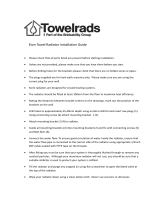 TOWELRADS 2805BTU Installation guide
TOWELRADS 2805BTU Installation guide
-
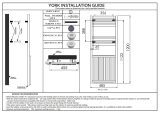 Reina A-YRK1248C Installation guide
Reina A-YRK1248C Installation guide
-
Optima Scale Floor User guide
-
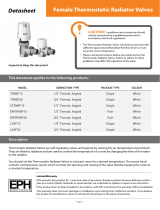 EPH Controls Thermostatic Radiator Valves Installation guide
EPH Controls Thermostatic Radiator Valves Installation guide
-
Weil-McLain High Trim Owner's manual
-
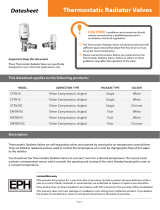 EPH Controls Thermostatic Radiator Valves Installation guide
EPH Controls Thermostatic Radiator Valves Installation guide
-
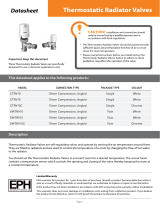 EPH Controls Thermostatic Radiator Valves Installation guide
EPH Controls Thermostatic Radiator Valves Installation guide
-
Alesis Point Seven Owner's manual
-
Alesis ADAT-HD24EC2 User manual
































